Atlantis Reef was discovered in September 2011 by Steven Benjamin of Animal Ocean. The site was named for the lost city which is (according to legend) submerged now, but was also known as the Pillars of Hercules prior to its rediscovery by Animal Ocean. Atlantis comprises two massive pinnacles that rise to within 4-5 metres of the surface, along with a jumbled collection of enormous boulders strewn about their base. We dived the site in mid-October from the BlueFlash boat, in conditions of almost top to bottom visibility. The topography of the site is breathtaking – huge, vertical walls and enormous rocks distinguish it from the lower rocky reef characteristics of the Roman Rock area. The sand lies at about 30 metres on the seaward (eastern) side of the reef, but the average depth is about 20 metres. With a large cylinder full of a nice Nitrox mix, you could dive here for days (water temperature permitting).
- Tony over the giant arrowhead (pointing towards the top of the photo)
- Fish feeding on the top of a pinnacle
- Fissures in the granite of the reef provide homes for fish
- One side of the inshore pinnacle
- Huge boulders stacked one on top of the other
- Massive granite boulders characterise the site
- The pinnacles drop down very sharply
- Visibility was almost top to bottom when we dived Atlantis
- Lower down on the pinnacle, more sea fans and invertebrates appear
- The side of the inshore pinnacle, near the surface
- Redbait and urchins cover the tops of the pinnacles
- Kelp in the shallow water on top of the pinnacle
- The site has many vertical walls
- Kelp growing on top of the shallower pinnacle
- Fish above the redbait that crowns the pinnacles
- Fish feeding atop a pinnacle
- View from above of the top of the inshore pinnacle
- The pinnacles drop off steeply
- Tightly packed redbait in the shallows
- Cape rock crab hiding among the redbait on top of one of the pinnacles
- Redbait and kelp on top of the pinnacle
We dropped right on top of the pinnacle closest to shore, and Grant hadn’t used a shot line for fear of damaging the pristine and hardly dived reef. Tony and Justin went down to the sand in order to do a compass swim for Justin’s Deep Specialty course, and I hovered next to one of the pinnacles. The pinnacles are about 3 metres across on their tips, but widen out to a large, roughly rectangular base on the sand. Between the pinnacles is a large overhang, and large cracks in which we saw congregations of janbruin. We spotted some very large (more than 30 centimetre long) zebra and Roman between the pinnacles, as well as some white seacatfish also enjoying one of the cracks in the rock. I discovered some fascinating facts about Roman this week, but they can wait…
- School of fish between the pinnacles
- Massive school of hottentot, fransmadam and other fish
- Fish feeding among the redbait on top of one of the pinnacles
- A klipfish hides on the reef
- Hottentot swim past the pinnacle
- School of fish between the pinnacles
To me, the most spectacular feature of the marine life on the reef is the large schools of fish that assemble around the pinnacles. The reef lies within the Castle Rocks Protected Area and no fishing is allowed there, and it obviously hasn’t been discovered by the fishermen – both commercial and amateur – who don’t care about protected areas and enjoy the fact that they aren’t policed at all. Hottentot, fransmadam, and zebra mill around in their hundreds – I have never seen a school of fish like this in the Cape. The strepies at Long Beach last summer were – until now – the most prolific fish I’ve seen here. The fish are quite relaxed and just reshaped their school around the divers.
- Granular sea star
- Sinuous sea fan on Atlantis Reef
- Anemones, urchins, corals and sea fans cover the upper reaches of the pinnacles
- Colourful sea garden on Atlantis Reef
- A knobbly anemone among sea fans, sea cucumbers and other invertebrate bounty
- A walking anemone hiding himself
- Two gas flame nudibranchs grappling
- Puffed up anemone
- Baby sea fans
There are also the usual sea fans (plus what looked like a nursery for baby sea fans), massive nudibranchs of several varieties, sea cucumbers, anemones, and a lot of other invertebrate life. The top parts of the pinnacles are covered with huge redbait, interspersed with Cape urchins and several varieties of sea anemone. Lower down on the pinnacles we found orange wall sponges and other sponge species, as well as large klipfish trying to camouflage themselves against the wall.
There was some interesting discussion about whether it is right to have an “exclusive” dive site that only you know the co-ordinates to. An argument was put forward that when one finds a pristine spot like this, it’s natural to want to protect it from careless, ignorant or inexperienced divers. Hopefully the boat charters – all of whom now know where this reef is – will put aside financial considerations when taking divers to this reef, and only allow divers who they know can manage their buoyancy and don’t engage in behaviours that are detrimental to the marine life of the locations they dive. Whether this happens will remain to be seen. (I, for one, am not optimistic… Enjoy it now, while it lasts.)
- A riot of colour on Atlantis Reef
- Dense invertebrate life on the pinnacles
- Knobbly anemone (right) on Atlantis Reef
- Anemone on Atlantis Reef
- Can you see the smiley face?
- A red sea star among coraline algae and strawberry sea anemones
- A sea star gets a grip and holds on tight
- Frilled nudibranch at Atlantis Reef
I want to go back to this site tomorrow, or yesterday if that’s possible. I’ve been (irritatingly) ranting about it to whoever will listen since we dived it. It’s wonderful to me that we are still finding new places to dive in our local bay of plenty, and so close to shore, too! Also, seeing how healthy and abundant the fish that call this reef home are, I’m thrilled that (it seems) the Marine Protected Areas are working, despite hopelessly inadequate support from the authorities. It made me so, so happy to see this reef. Can’t wait to go back!
Dive date: 15 October 2011
Air temperature: 19 degrees
Water temperature: 13 degrees
Maximum depth: 21.5 metres
Visibility: 15 metres
Dive duration: 40 minutes



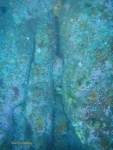


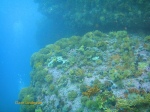
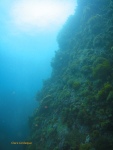
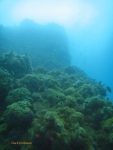
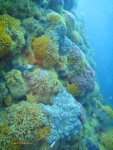
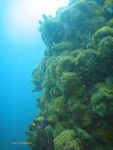
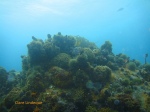
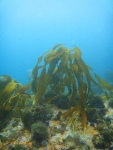


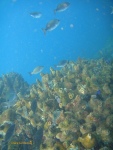
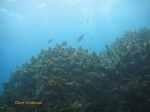
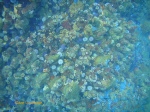
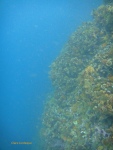
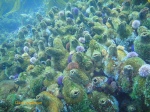

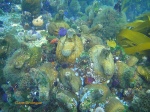

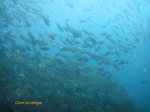



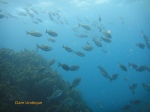



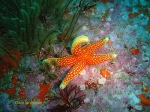
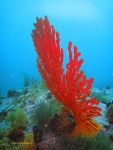
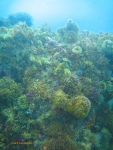
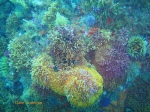
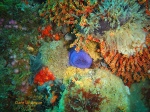
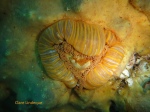
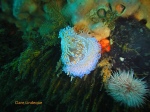
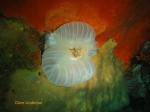
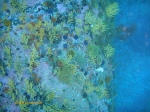

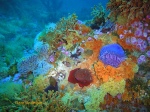
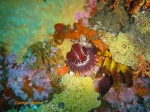
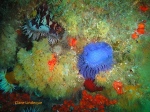
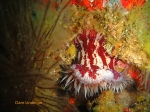
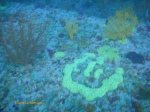

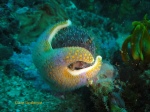
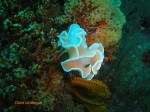




Leave a comment